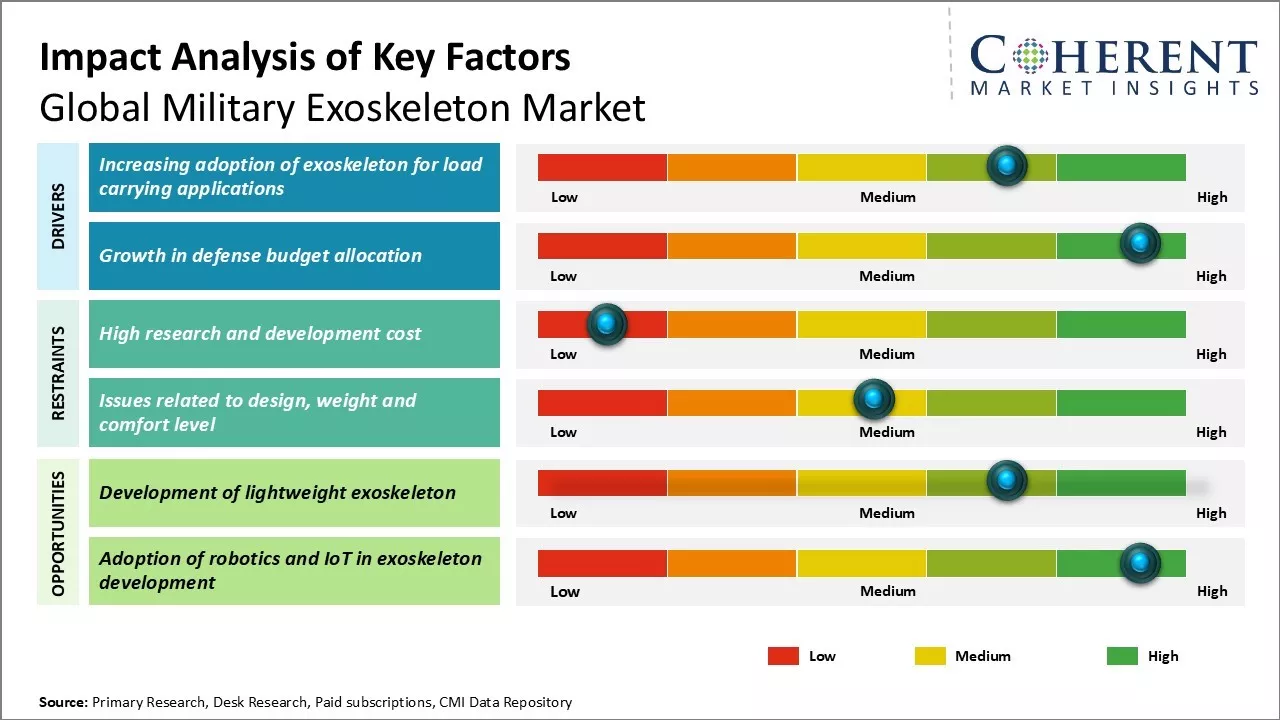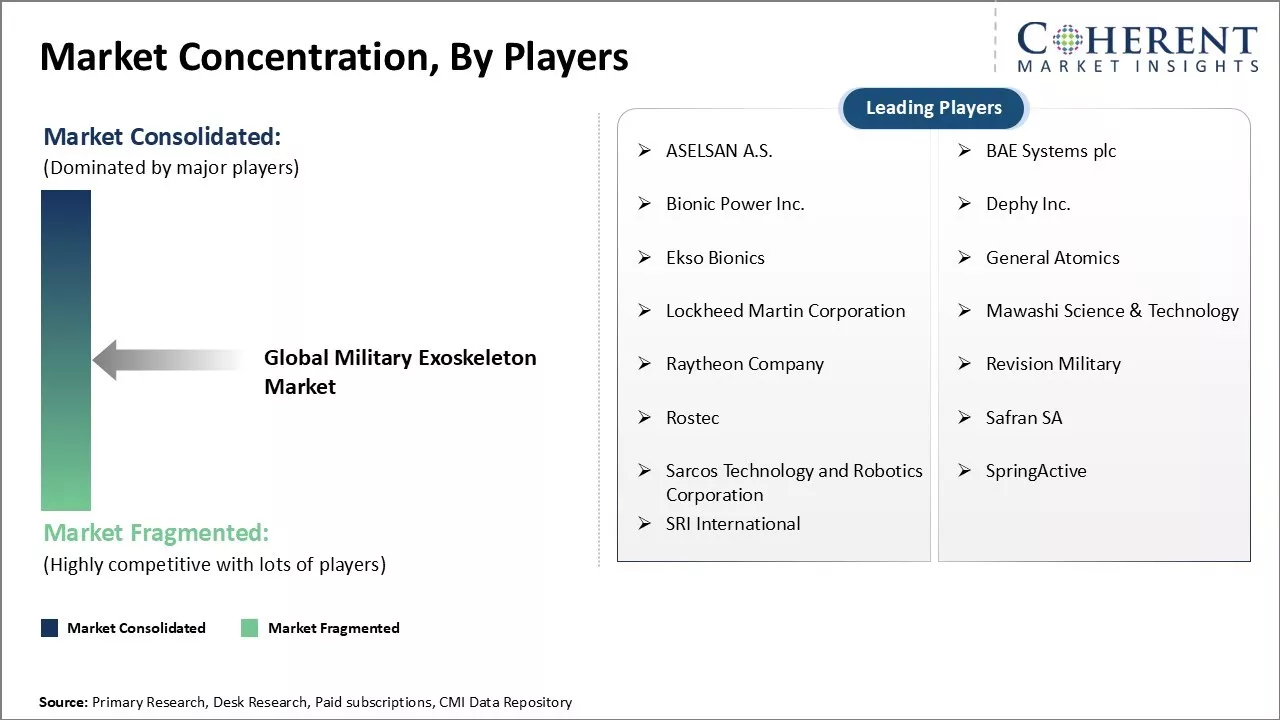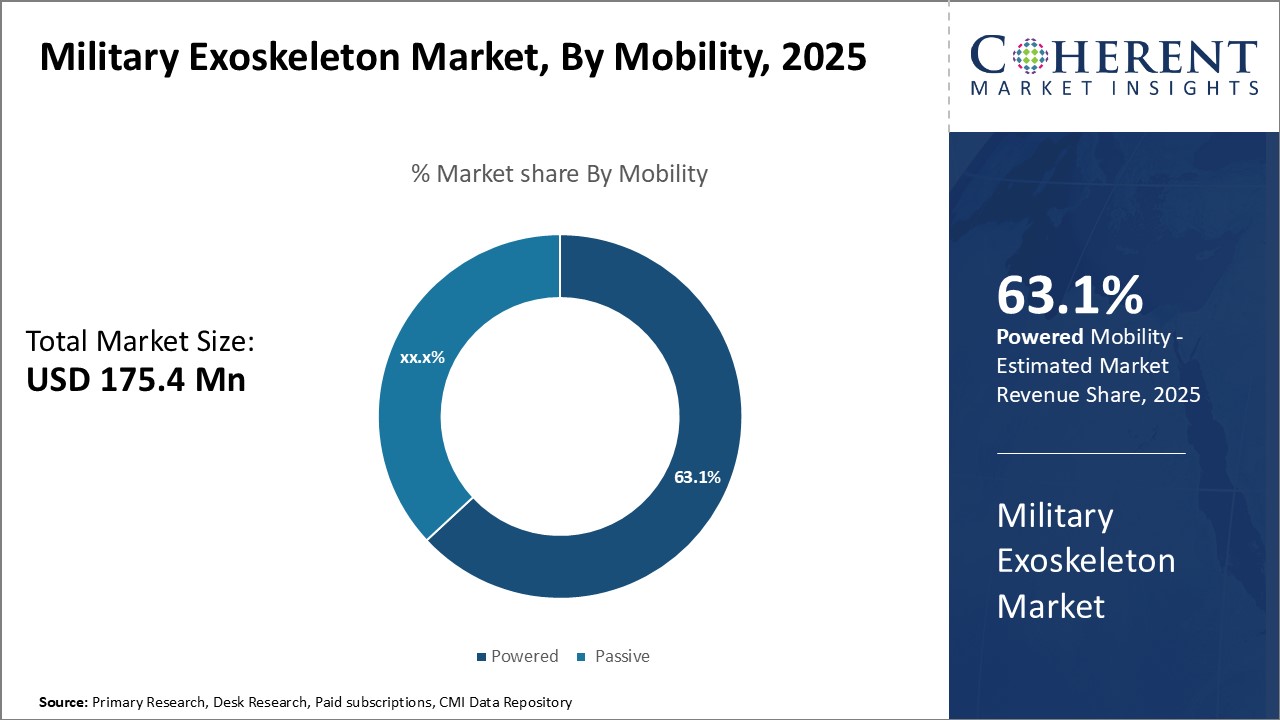Global military exoskeleton market is estimated to be valued at US$ 175.4 Mn in 2025 and is expected to reach US$ 452.9 Mn by 2032, exhibiting a compound annual growth rate (CAGR) of 14.5% from 2025 to 2032.

Discover market dynamics shaping the industry: Download Free Sample
Increasing investment in defense technologies by various countries and rising application of powered exoskeleton suits across different military operations for enhanced soldier protection and mobility can boost demand for military exoskeleton.
Market Driver - Increasing adoption of exoskeleton for load carrying applications
Growing focus on enhancing soldier mobility and safety has boosted adoption of military exoskeletons for load carrying applications. Military personnel, particularly infantry forces, are often required to march for extended periods carrying heavy gear weighing upto 50 kgs or more. This places tremendous physical strain and can even lead to long term injuries. Exoskeletons help alleviate this burden by actively assisting in lifting and carrying the load.
Heavy load carrying hinders agility and speed of response. Exoskeletons enable the same soldier to carry equivalent load with minimal exhausting effects. This translates to better endurance and performance in combat zones. Coupled with advancing terrain navigation technologies, exoskeletons allow small mobile units to operate independently for longer duration missions.
Several armies including U.S., U.K., France, and Israel, among others have started pilot programs and limited procurement of exoskeleton prototypes mainly for this load carrying function. Key manufacturing companies such as Lockheed Martin, Ekso Bionics, and Sarcos Defense have partnered with military research organizations to refine exoskeleton design matching army requirements. Latest models use battery powered actuators and pneumatic muscles to support the load through intuitive controls. Some versions offer additional assistance like powered knee joints for stair climbing.
Safety of soldiers is a top priority and exoskeletons can prevent debilitating musculoskeletal injuries from repeated weight loading. Concerns around operational challenges like reliability in adverse zones can get addressed through rigorous testing under crucial conditions. As military exoskeleton technology matures in tandem with soldier needs, their adoption rates for load carrying roles can witness strong growth.

Get actionable strategies to beat competition: Download Free Sample
Growth in Defense Budget Allocations
Defense spending remains critical for military modernization plans globally. Most nations focus budgetary allocations towards equipping forces with new age systems and force multipliers. Exoskeletons, which optimize soldiers' efficiency, are gaining favor with military strategists. The big spending nations like the U.S. followed by China and some European countries are upping committed fund allotments for technologies enhancing national security.
The geopolitical scenario warrants stronger security postures. This has led to increase in military budgets across regions. Top investing countries are prioritizing soldier welfare while preparing against new threats using advanced equipment. Exoskeletons fitted with vision and communication aids are seen as force multipliers by military planners seeking competitive edge over adversaries.
Rising financial provisions encourages innovation in defense tech as larger R&D contracts are awarded. Various exoskeleton projects get accelerated to production phases quicker with guaranteed funding support. Whereas earlier these were limited to small initial procurement batches for trials. Leading armed forces are now inducting select models for wider operational deployment after extensive field tests. This spurs related manufacturing and maintenance activities creating spin-off demand.
Key Takeaways from Analyst:
Global military exoskeleton market growth is driven by growing need to augment a soldier's strength and endurance as many military forces are actively investing in exoskeleton technologies. The ability of exoskeletons to reduce physical fatigue and load carriage is massively appealing to armed forces. Ongoing R&D efforts to develop lighter and more efficient powered exoskeletons can expand the scope of applications from load carrying to potentially aiding in rescue operations. However, high development costs can hamper the market growth.
North America currently dominates the market due to the region's defense modernization programs and presence of leading innovators. The U.S. is actively funding various exoskeleton development programs through DARPA and army research labs. Asia Pacific region is expected to emerge as the fastest growing market. Countries like China and South Korea are ramping up their defense spending and view exoskeletons as important for military mobility and modernization.
Weight reduction, improved power-to-weight ratios, enhanced user comfort and artificial intelligence/sensor integration into exosuits will be critical in driving broader uptake. Successful demonstration of practical utility under operational conditions can offer investment opportunities.
Market Challenge - High research and development cost
Global military exoskeleton market growth can be hampered due to high research and development costs associated with designing and manufacturing advanced military exoskeletons. Developing exoskeletons that can improve soldier mobility and endurance while carrying heavy equipment requires extensive R&D investment. Exoskeleton technologies involve multiple fields including mechanical engineering, electrical engineering, computer science, physiology and many others. Extensive testing under real world conditions is also required to validate design concepts and ensure soldier safety. The high costs deter many companies from actively investing in this market. Long development cycles associated with such complex technological developments limit quick returns on investments. Military budgets are also limited, which restrict procurement of such advanced technologies in the initial years. This high cost barrier poses significant challenges for the market growth in the near future.
Opportunity- Development of lightweight exoskeletons
Development of lightweight exoskeleton designs can offer market growth opportunities. Lightweight exoskeletons can help address issues like soldier fatigue and overcoming the challenge of high payload. Market leaders are investing in research focusing on utilizing high strength lightweight alloys, composite materials and better power sources to develop exoskeletons weighing below 20 kgs. Lightweight exoskeletons can significantly reduce operational stresses on soldiers and improve mission capabilities by allowing longer duty periods in hostile terrains and weather. Their miniaturized designs can also accommodate soldiers weapons and heavy gear. Development of such lightweight technologically advanced solutions provide a huge opportunity to drive the military exoskeleton market growth in the future.

Discover high revenue pocket segments and roadmap to it: Download Free Sample
Insights By Mobility- Powered Military Exoskeletons Drive Technological Advancement
In terms of mobility, powered segment is expected to contribute the 63.1% market share in 2025, due to their ability to augment a soldier's strength and endurance through electric motors and onboard batteries. Powered exoskeletons allow soldiers to carry heavy loads of up to 200 pounds for extended periods of time without fatigue, thus, enabling them to operate more effectively on the battlefield.
These battery-powered suits not only boost wearers' lifting and walking capabilities, but are being increasingly integrated with advanced sensing and control systems. Miniaturized sensors detect soldiers' bio-signals and intended movements, allowing exoskeleton motors to smoothly assist natural motions. Onboard processors then analyze sensor data to optimize power usage and joint load redistribution. Over time, continued technological refinements can make powered exoskeletons even more intuitiveto use with minimal training.
The development of lightweight yet powerful lithium-ion batteries is also crucial to advancing powered exoskeleton functionality. Extended battery life directly translates to improved endurance for soldiers on missions. Researchers are concurrently working on novel energy harvesting techniques such as scavenging power from wearers' own biomechanical energy. Such alternate solutions could eliminate the need for periodic charging stops and enable truly untethered powered exoskeleton operation.
Superior load carriage, endurance-boosting and mobility-enabling abilities of powered exoskeletons over passive versions boosts their widespread adoption among military forces seeking to upgrade soldiers' physical capacities through cutting-edge mechanized augmentation. Technological refinements centered on human-machine interfaces, power sources and energy autonomy can drive the powered exoskeleton segment growth.
Insights By Application- Logistical Challenges Boosts Demand for Logistics Support Exoskeletons
In terms of application, logistics support segment is expected to account for the highest market share of 39.8% in 2025. The complex logistical needs of military operations, ranging from transporting heavy equipment and supplies to warehouse inventory management, pose immense physical strains on personnel. Exoskeletons that enhance load carriage, warehouse labor and transportation worker endurance witness huge demand to address these challenges.
Many logistical roles require soldiers to lift, carry or manipulate loads of 50 poundsor more on a regular basis, risking muscular fatigue and injury over extended periods. Exoskeletons redistribute weight across the body and power some motions to effectively lighten loads, reducing physiological stresses. These also offer software features like inventory tracking and navigation assistance tailored for logistical applications. The ability of exoskeletons to boost worker productivity makes them a cost-efficient solution for combating logistical workforce shortages or high personnel turnover due to work-related injuries.
Exoskeletons optimized for logistical roles help military logistical teams meet these intensifying demands through physical capabilities enhancement. Their versatility in assisting with a variety of logistical activities further cements exoskeleton devices as a solution of choice for the rising needs of modern military logistical support worldwide.
Insights By End User- Army Adoption Drives Robust Exoskeleton Procurement
In terms of end user, army segment is expected to contribute the highest market share of 51.8% in 2025, due to the extensive full-body strength and mobility augmentation needs of ground force operations. With troops shouldering heavy rucksacks and weaponry across rugged, uneven terrain during combat, training and patrol missions, army exoskeletons help alleviate strain on the body from excessive load carriage.
Army exoskeleton models are designed with durability and mobility in mind. These optimize load distribution across the lower back, hips and legs to reduce exhaustion over long marching periods. Their flexible frames and joints facilitate a natural gait for traversing all types of grounds while carrying up to 50 extra pounds of gear, allowing army units to maintain an accelerated operational tempo on deployments.
As frontline clashes evolve from full mechanization to more dismounted infantry scenarios, exoskeletons that boost soldier agility and endurance without hindering mobility witness expanded procurement across army divisions globally. Lightweight upper body exoskeletons are also gaining popularity for aiding medical evacuations, firefighting activities and bomb disposal operations that require heavy lifting or prolonged arm motions. The versatile performance benefits of army exoskeletons for diverse ground missions have propelled their prominent role in fulfilling army modernization and soldier enhancement goals.

Need a Different Region or Segment? Download Free Sample
North America has emerged as the dominant regional market for military exoskeletons globally with 37.6% share in 2025, due to high defense expenditure of the U.S., which is the largest developer and spender on defense technologies. The country has been at the forefront of developing various powered and non-powered exoskeleton solutions for soldiers. Most of the major exoskeleton manufacturers such as Lockheed Martin, BAE Systems, and General Dynamics have a strong presence in the region and are continuously investing in R&D to develop advanced solutions. The U.S. army has also initiated several programs to integrating exoskeleton technologies and has provided funding to projects that can enhance soldier mobility and reduce fatigue. With government support and large scale testing of prototypes, the North American market is expected to further strengthen its position in the future.
Asia Pacific region has witnessed highest growth in the military exoskeleton market over the past few years and is emerging as the fastest growing regional market. Countries like China and Japan have scaled up their defense spending extensively to develop indigenous defense technologies. China especially has emerged as a rising player with both domestic manufacturers as well as integrators developing military exoskeleton solutions. These have received support from government defense modernization programs. Several companies are engaged in export of affordable lower limb exoskeleton solutions to other Asian and Middle Eastern countries. The presence of a large talent pool with capabilities in robotics and mechatronics along with cost competitiveness provides an impetus for regional and global companies to consider Asia Pacific region for manufacturing of components.
Military Exoskeleton Market Report Coverage
| Report Coverage | Details | ||
|---|---|---|---|
| Base Year: | 2024 | Market Size in 2025: | USD 175.4 Mn |
| Historical Data for: | 2020 To 2024 | Forecast Period: | 2025 To 2032 |
| Forecast Period 2025 to 2032 CAGR: | 14.5% | 2032 Value Projection: | USD 452.9 Mn |
| Geographies covered: |
|
||
| Segments covered: |
|
||
| Companies covered: |
ASELSAN A.S., BAE Systems plc, Bionic Power Inc., Dephy Inc., Ekso Bionics, General Atomics, Lockheed Martin Corporation, Mawashi Science & Technology, Raytheon Company, Revision Military, Rostec, Safran SA, Sarcos Technology and Robotics Corporation, SpringActive, SRI International |
||
| Growth Drivers: |
|
||
| Restraints & Challenges: |
|
||
Uncover macros and micros vetted on 75+ parameters: Get instant access to report
*Definition: Global Military Exoskeleton Market consists of technology that enhances a soldier's strength, speed, endurance and mobility. Military exoskeletons can help carry heavy loads, reduce fatigue, and provide protection. They can be powered or passive, and are used in applications like material handling, joint assistance, and injury rehabilitation.
Share
Share
About Author
Suraj Bhanudas Jagtap is a seasoned Senior Management Consultant with over 7 years of experience. He has served Fortune 500 companies and startups, helping clients with cross broader expansion and market entry access strategies. He has played significant role in offering strategic viewpoints and actionable insights for various client’s projects including demand analysis, and competitive analysis, identifying right channel partner among others.
Missing comfort of reading report in your local language? Find your preferred language :
Transform your Strategy with Exclusive Trending Reports :
Frequently Asked Questions
Joining thousands of companies around the world committed to making the Excellent Business Solutions.
View All Our Clients